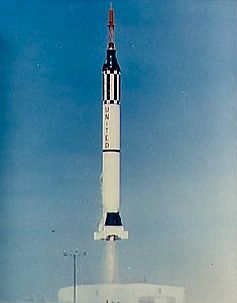
Mercury-Redstone 1A
Encyclopedia

Mercury program
Mercury Program might refer to:*the first successful American manned spaceflight program, Project Mercury*an American post-rock band, The Mercury Program...
-Redstone
Mercury-Redstone Launch Vehicle
The Mercury-Redstone Launch Vehicle, designed for NASA's Project Mercury, was the first American manned space booster. It was used for six sub-orbital Mercury flights from 1960–61; culminating with the launch of the first, and 11 weeks later, the second American in space.A member of the...
1A (MR-1A) was launched on December 19, 1960 from LC-5
Cape Canaveral Air Force Station Launch Complex 5
Launch Complex 5 was a launch site at Cape Canaveral Air Force Station, Florida used for various Redstone and Jupiter launches.It is most well known as the launch site for NASA's 1961 suborbital Mercury-Redstone 3 flight, which made Alan Shepard the first American in space. It was also the launch...
at Cape Canaveral
Cape Canaveral
Cape Canaveral, from the Spanish Cabo Cañaveral, is a headland in Brevard County, Florida, United States, near the center of the state's Atlantic coast. Known as Cape Kennedy from 1963 to 1973, it lies east of Merritt Island, separated from it by the Banana River.It is part of a region known as the...
, Florida
Florida
Florida is a state in the southeastern United States, located on the nation's Atlantic and Gulf coasts. It is bordered to the west by the Gulf of Mexico, to the north by Alabama and Georgia and to the east by the Atlantic Ocean. With a population of 18,801,310 as measured by the 2010 census, it...
. The mission objectives of this unmanned suborbital flight were to qualify
Flight qualify
To flight qualify is to take a product, process, or material and test it in order to prove that it will withstand the environment of aerodynamic or space flight...
the spacecraft for space flight and qualify the system for an upcoming primate suborbital flight. The spacecraft tested its instrumentation, posigrade rockets, retro rockets and recovery system. The mission was completely successful. The Mercury capsule reached an altitude of 130 miles (209.2 km) and a range of 235 miles (378.2 km). The launch vehicle reached a slightly higher velocity than expected - 4909 miles per hour (7,900.3 km/h). The Mercury spacecraft was recovered from the Atlantic Ocean
Atlantic Ocean
The Atlantic Ocean is the second-largest of the world's oceanic divisions. With a total area of about , it covers approximately 20% of the Earth's surface and about 26% of its water surface area...
by recovery helicopters about 15 minutes after landing. Serial numbers: Mercury Spacecraft # 2 together with the escape tower from Capsule # 8, and the antenna fairing from Capsule # 10 were reflown on MR-1A. Redstone MRLV-3 was used. Flight time 15 minutes 45 seconds.
Current location
Mercury spacecraft #2, used in both the Mercury-Redstone 1 and Mercury-Redstone 1A missions, is currently displayed at the Exploration Center at NASA Ames Research CenterNASA Ames Research Center
The Ames Research Center , is one of the United States of America's National Aeronautics and Space Administration 10 major field centers.The centre is located in Moffett Field in California's Silicon Valley, near the high-tech companies, entrepreneurial ventures, universities, and other...
, Moffett Federal Airfield
Moffett Federal Airfield
Moffett Federal Airfield , also known as Moffett Field, is a joint civil-military airport located between northern Mountain View and northern Sunnyvale, California, USA. The airport is near the south end of San Francisco Bay, northwest of San Jose. Formerly a United States Navy facility, the former...
, near Mountain View
Mountain View, California
-Downtown:Mountain View has a pedestrian-friendly downtown centered on Castro Street. The downtown area consists of the seven blocks of Castro Street from the Downtown Mountain View Station transit center in the north to the intersection with El Camino Real in the south...
, California
California
California is a state located on the West Coast of the United States. It is by far the most populous U.S. state, and the third-largest by land area...
.
Mercury-Redstone suborbital flight events

| T+ Time | Event | Description |
|---|---|---|
| T+00:00:00 | Liftoff | Mercury-Redstone lifts off, onboard clock starts. |
| T+00:00:16 | Pitch Program | Redstone pitches over 2 deg/s from 90 deg to 45 deg. |
| T+00:00:40 | End Pitch Program | Redstone reaches 45 deg pitch. |
| T+00:01:24 | Max Q | Maximum dynamic pressure ~575 lb/ft² (28 kPa). |
| T+00:02:20 | BECO | Redstone engine shutdown - Booster Engine Cutoff. Velocity 5,200 mph (2.3 km/s) |
| T+00:02:22 | Tower Jettison | Escape Tower Jettison, no longer needed. |
| T+00:02:24 | Capsule Separation | Posigrade rockets fire for 1 s giving 15 ft/s (4.6 m/s) separation. |
| T+00:02:35 | Turnaround Maneuver | Capsule (ASCS) system rotates capsule 180 degrees, to heat shield forward attitude. Nose is pitched down 34 degrees to retro fire position. |
| T+00:05:00 | Apogee | Apogee of about 115 miles (185 km) reached at 150 miles (240 km) downrange from launch site. |
| T+00:05:15 | Retrofire | Three retro rockets fire for 10 seconds each. They are started at 5 second intervals, firing overlaps. Delta V of 550 ft/s (168 m/s) is taken off forward velocity. |
| T+00:05:45 | Retract Periscope | Periscope is automatically retracted in preparation for reentry. |
| T+00:06:15 | Retro Pack Jettison | One minute after retrofire retro pack is jettisoned, leaving heatshield clear. |
| T+00:06:20 | Retro Attitude Maneuver | (ASCS) orients capsule in 34 degrees nose down pitch, 0 degrees roll, 0 degrees yaw. |
| T+00:07:15 | .05 G Maneuver | (ASCS) detects beginning of reentry and rolls capsule at 10 deg/s to stabilize capsule during reentry. |
| T+00:09:38 | Drogue Parachute Deploy | Drogue parachute deployed at 22,000 ft (6.7 km) slowing descent to 365 ft/s (111 m/s) and stabilizing capsule. |
| T+00:09:45 | Snorkel Deploy | Fresh air snorkel deploys at 20,000 ft (6 km). (ECS) switches to emergency oxygen rate to cool cabin. |
| T+00:10:15 | Main Parachute Deploy | Main parachute deploys at 10,000 ft (3 km). Descent rate slows to 30 ft/s (9 m/s) |
| T+00:10:20 | Landing Bag Deploy | Landing Bag Deploys, dropping heat shield down 4 ft (1.2 m). |
| T+00:10:20 | Fuel Dump | Remaining hydrogen peroxide fuel automatically dumped. |
| T+00:15:30 | Splashdown | Capsule lands in water about 300 mi (500 km) downrange from launch site. |
| T+00:15:30 | Rescue Aids Deploy | Rescue aid package deployed. The package includes green dye marker, recovery radio beacon and whip antenna. |
External links
- "Space Progress: 'Man-In-Space' Capsule Recovery Successful", a December 22, 1960 Universal-InternationalUniversal NewsreelUniversal Newsreel was a series of 7- to 10-minute newsreels that were released twice a week between 1929 and 1967 by Universal Studios. A Universal publicity official, Sam B. Jacobson, was involved in originating and producing the newsreels...
newsreelNewsreelA newsreel was a form of short documentary film prevalent in the first half of the 20th century, regularly released in a public presentation place and containing filmed news stories and items of topical interest. It was a source of news, current affairs and entertainment for millions of moviegoers...
briefly covering the Mercury-Redstone 1A mission. Courtesy of the Internet ArchiveInternet ArchiveThe Internet Archive is a non-profit digital library with the stated mission of "universal access to all knowledge". It offers permanent storage and access to collections of digitized materials, including websites, music, moving images, and nearly 3 million public domain books. The Internet Archive...
. - Mercury spacecraft #2 display page on "A Field Guide to American Spacecraft" website.

